

CONTENTS
To my seminarians
It is above all through the liturgy that Christians come into contact with scripture... Christ is then present in his word, because it is he himself who speaks when sacred scripture is read in the Church. Written text thus becomes living word.
P ONTIFICAL B IBLICAL C OMMISSION,
The Interpretation of the Bible in the Church
FOREWORD
By Jeremy Driscoll, O.S.B.
A WONDROUS THOUGHT: God, the Lord of the Universe, has spoken to us a saving Word! But how can we be sure that it is the Lord's Word we hear? Where do we hear it? In the scriptures, of course. Yesbut how can we know that we are reading these rightly, that what we understand is what they truly mean? There is an answer. The scriptures are heard rightly when they are read in the heart of the church, and this happens at the heart of the liturgy.
Scott Hahn's book Letter and Spirit is an extensive exploration of how the scriptures come alive and reach their fullest pitch as they are proclaimed in the liturgical assembly of the believing church. As the author succinctly puts it, scripture is about liturgy and for liturgy. All who study and reflect about scripture will want to learn wellor be reminded ofthe basic point of this book: namely, that it was the community at worship that produced the biblical texts and it is in the community at worship that these texts find their fullest sense. This book substantiates this claim and develops its consequences for biblical interpretation. It does so by reviewing the theological terms, exploring the key theological concepts, and discussing the liturgical practices that build up this whole biblical-liturgical world. That said, scripture, of course, emerges also out of the community's lived experience of its covenant with God, and it makes sense of our everyday lives, of our sufferings and joys.
While Dr. Hahn was writing this book, he was reading one I had written, and I too was writing another while reading one of his. I was reading The Lamb's Supper ; he was reading my Theology at the Eucharistic Table. We had the opportunity to speak together several times during this period and found that much of what we wanted to do was converging. His kind invitation to write this introduction came from those exchanges, an invitation that bid me share some of the points where our books touch closely. The book I was writing at the time is called What Happens at Mass, and it deals in part with what Letter and Spirit deals with at length. While my book covers all the parts of the Mass, Dr. Hahn's concentrates on one essential and indispensable part of it: the proclamation of the Word of God. Understanding this is essential to understanding the rest of the Mass. The eucharistic liturgy is the deepest sense of the proclaimed Word.
In thinking of the structure of the entire eucharistic rite, as I do in What Happens at Mass, it is useful to be aware that it embodies a twofold movement: a movement of God toward the world and of the world toward God. This movement in fact unfolds in a trinitarian and ecclesial shape; that is, God the Father comes through his Son to the church for the sake of the world, and the Spirit illumines and vivifies every dimension of this movement. In the other direction, the church, speaking in the name of the whole world, responds in thanksgiving by offering to the Father the very gift she has received: the Son. The Spirit effects the transformation of the church's gifts into the Body and Blood of the Son.
In the liturgy of the Wordit is here that Letter and Spirit is concentratedthis twofold movement is enacted by means of speech. God speaks, and we speak back. If we unfold this into its trinitarian and ecclesial shape, we can say that God speaks through his Son in the Holy Spirit to the church; and the church responds. Christ stands exactly in the middle position of these two directions of movement, and thus he is named Mediator. What God says to the world is his Son, Christ. What the world says back to God is also Christ, the Word made flesh, joined to the church. The church also plays the role of mediator here. God speaks to the world in speaking to the church. The church speaks for the world in responding to God. To show that this is the fullest sense and use of scripture is the concern of Dr. Hahn's book.
In our discussions Dr. Hahn and I found ourselves especially excited about the convergence in our thoughts on something I callhaving learned the term from the great Italian liturgist Salvatore Marsilithe event character of the proclamation of the Word. The Word of God in the liturgy of the Word does not mean the words of the Bible considered merely as words like our words. The Word of God is an event: the event of creation and the event of what God is doing and saying in Israel and finally the event of what God is doing and saying in Jesus. The words of the Bible narrate the event. They are a precious means to us, for they are given by the Holy Spirit. As such, they carry far more than mere human words can carry. They carry the very events of which they speak, and in their formulation is revealed the deepest meaning of the event. In the proclamation of these words, the event proclaimed becomes present. The words in the book are rather like the notes of a musical score. The score is not the music. But the score lets the music sound. When from the score of the biblical book the words are proclaimed in the midst of a believing assembly, the music of God's events sounds forth in the midst of that assembly! What is the basic shape of the music? God speaks to the world, and the world speaks to God. God says his Son to the world, and the world says itself as Son back to God.
No matter what particular readings occur in a given liturgy, the liturgy of the Word always has about it an event character; that is, the events of the past that are proclaimed become events for the believing community that hears them told. And all the events of the scripture find their center in the one event that is the center of them all: the death and resurrection of Jesus. It is this about which all the scriptures speak. Every proclamation of the Word in the liturgy is an irreducibly new moment. The event of Christ in and through which God once acted to save his people, that same event is delivered here and now to this assembly by means of the biblical score, the gift of the Spirit to the church.
The event of Christand of course, all the events of scripture are the event of Christbecomes the event of the church. The Word proclaimed in liturgy is not some pale reflection or residue of the event proclaimed there. It is the whole reality to which the words bear testimony made present. What was spread out as a series of events through time is now concentrated into the one event of this liturgy. Readers of Letter and Spirit will deepen their grasp of all these various dimensions of the biblical words, whose sense expands more and more when proclaimed in the liturgical assembly. I am saying only briefly here what this book spells out at length, justifying these claims historically and theologically.
As the book's arguments advance and the evidence mounts, the reader will gain a stronger and stronger sense of the presence of Christ, the intense presence of Christ, in the proclaimed Word. To speak with the language of some of the chapters' titles, we could say that the covenantin some sense always the content of the biblical textis actualized as it is remembered. This actualization is nothing less than a parousia, a coming of Christ that already participates in his definitive coming in glory. This is the living sense of traditionnot old ideas from the past that we still for some reason hold on to, but the divine presence that emerges through the written word of scripture in the here and now of the assembly animated by the Spirit. This intense presence of Christ is Apocalypse, that is, a vision that opens into the heavenly liturgies unveiled in the last book of the Bible. Mystagogy is the Church's way of teaching the biblical text such that its words open into this widest heavenly sense, a sense whose future fullness already invades the present of liturgical proclamation.
Next page
![Scott Hahn [Inconnu(e)] Letter and Spirit: From Written Text to Living Word in the Liturgy](/uploads/posts/book/134755/thumbs/scott-hahn-inconnu-e-letter-and-spirit-from.jpg)

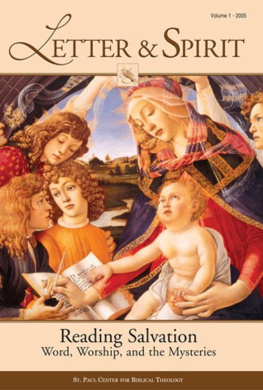
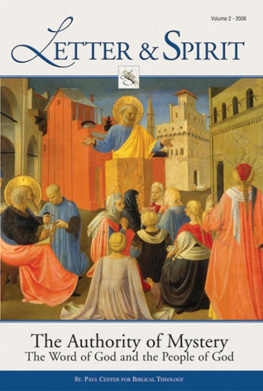
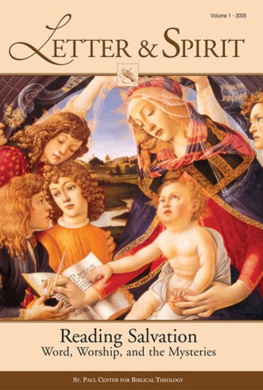
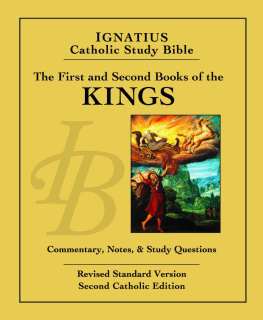
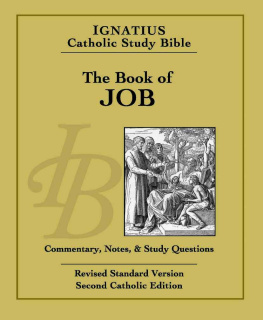


![Scott Hahn [Inconnu(e)] - Scripture Matters: Essays on Reading the Bible From the Heart of the Church](/uploads/posts/book/134760/thumbs/scott-hahn-inconnu-e-scripture-matters-essays.jpg)
![Scott Hahn [Inconnu(e)] - A Pocket Guide to the Bible](/uploads/posts/book/134750/thumbs/scott-hahn-inconnu-e-a-pocket-guide-to-the.jpg)

